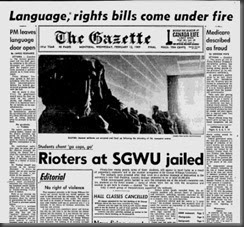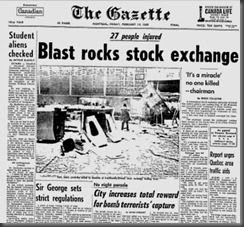On September 29th 1969 a bomb exploded at the house of Montreal Mayor Jean Drapeau. No one was injured but, as the newspaper report said, “The pre-dawn explosion which shook the neighbourhood… forced the mayor’s wife and son into a cold drizzle. They didn’t even have time to put on their shoes.”
This was the 10th bomb of 1969 to explode. Dozens of other bombs were defused by Sgt. Robert Coté and the bomb squad.
The Premiere of Quebec at the time, Jean-Jacques Bertrand, said the people of Quebec must avoid panic in the face of bomb terrorism. “The police forces are doing their job and it is our hope and expectation that those responsible for such outrages will be brought before the courts and the law will take its course.” Then he repeated the claim made by pretty much every official at the time that the bombs were being planted by “foreign nationals” who received “training in Cuba.” Then he made a joke, apologizing for calling the terrorists “beardos,” and saying, “Some of best friends have beards.”
Four days later the body of 20 year old Shirley Audette was found behind the apartment building she lived in on Dorchester Boulevard (now Boulevard René Lévesque) near Guy. She had been strangled. In the investigation it was discovered that she had been treated at a psychiatric hospital (the Douglas in Verdun) and was five weeks pregnant. She was the first victim of the “Vampire Killer.”
Four days after that the Montreal police went on a strike which lasted 16 hours and resulted in one death and 108 arrests. The strike was motivated by difficult working conditions caused by disarming so many separatist-planted bombs and patrolling frequent protests. The Montreal police also wanted to be paid the same as police in Toronto.
During the melée, Sûreté (provincial police) corporal Robert Dumas was killed by shots fired by security guards.
As the riot was ongoing, the provincial government passed an emergency law and forced the police back to work. The army was also called in but by the time the 22nd Regiment (known as the “Vandoos”) arrived at dawn the riot was over.
The CBC archive has some very good news footage from the day.
A couple months before Shirley Audette was killed, the Manson Family murders had taken place in California and the idea of “drug-crazed hippie-murders” was being talked about a lot.
The Vampire Killer’s second murder took place a few weeks later on November 23rd, a few days before the Canadian football championship game, the Grey Cup, was played in Montreal. The entire police force had spent the weeks before the game preparing for the possibility of a terrorist attack.
So, busy times.

